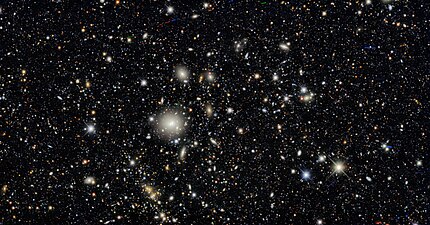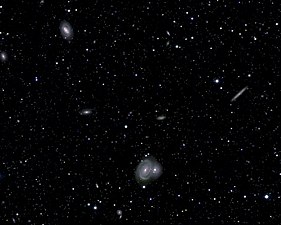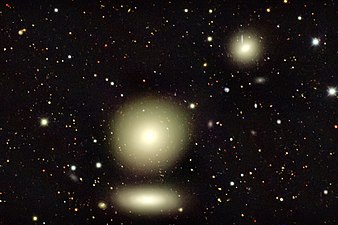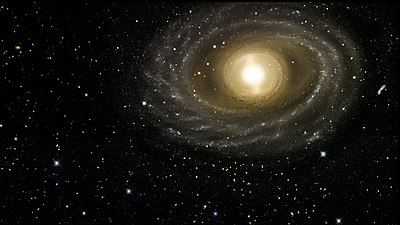Dark Energy Survey
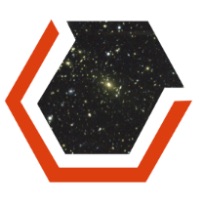 Dark Energy Survey logo | |
| Alternative names | DES |
|---|---|
| Website | www |
| | |
| Part of a series on |
| Physical cosmology |
|---|
 |
The Dark Energy Survey (DES) is an astronomical survey designed to constrain the properties of dark energy. It uses images taken in the near-ultraviolet, visible, and near-infrared to measure the expansion of the universe using Type Ia supernovae, baryon acoustic oscillations, the number of galaxy clusters, and weak gravitational lensing.[1] The collaboration is composed of research institutions and universities from the United States,[2] Australia, Brazil,[3] the United Kingdom, Germany, Spain, and Switzerland. The collaboration is divided into several scientific working groups. The director of DES is Josh Frieman.[4]
The DES began by developing and building Dark Energy Camera (DECam), an instrument designed specifically for the survey.[5] This camera has a wide field of view and high sensitivity, particularly in the red part of the visible spectrum and in the near infrared.[6] Observations were performed with DECam mounted on the 4-meter Víctor M. Blanco Telescope, located at the Cerro Tololo Inter-American Observatory (CTIO) in Chile.[6] Observing sessions ran from 2013 to 2019; as of 2021[update] the DES collaboration has published results from the first three years of the survey.[7]
DECam
[edit]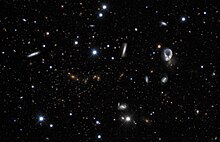
DECam, short for the Dark Energy Camera, is a large camera built to replace the previous prime focus camera on the Victor M. Blanco Telescope. The camera consists of three major components: mechanics, optics, and CCDs.
Mechanics
[edit]The mechanics of the camera consists of a filter changer with an 8-filter capacity and shutter. There is also an optical barrel that supports 5 corrector lenses, the largest of which is 98 cm in diameter. These components are attached to the CCD focal plane which is cooled to 173 K (−148 °F; −100 °C) with liquid nitrogen in order to reduce thermal noise in the CCDs. The focal plane is also kept in an extremely low vacuum of 0.00013 pascals (1.3×10−9 atm) to prevent the formation of condensation on the sensors. The entire camera with lenses, filters, and CCDs weighs approximately 4 tons. When mounted at the prime focus it was supported with a hexapod system allowing for real time focal adjustment.[9]
Optics
[edit]The camera is outfitted with u, g, r, i, z, and Y filters spanning roughly from 340–1070 nm,[10] similar to those used in the Sloan Digital Sky Survey (SDSS). This allows DES to obtain photometric redshift measurements to z≈1. DECam also contains five lenses acting as corrector optics to extend the telescope's field of view to a diameter of 2.2°, one of the widest fields of view available for ground-based optical and infrared imaging.[6] One significant difference between previous charge-coupled devices (CCD) at the Victor M. Blanco Telescope and DECam is the improved quantum efficiency in the red and near-infrared wavelengths.[11][9]
CCDs
[edit]
The scientific sensor array on DECam is an array of 62 2048×4096 pixel back-illuminated CCDs totaling 520 megapixels; an additional 12 2048×2048 pixel CCDs (50 Mpx) are used for guiding the telescope, monitoring focus, and alignment. The full DECam focal plane contains 570 megapixels. The CCDs for DECam use high resistivity silicon manufactured by Dalsa and LBNL with 15×15 micron pixels. By comparison, the OmniVision Technologies back-illuminated CCD that was used in the iPhone 4 has a 1.75×1.75 micron pixel with 5 megapixels. The larger pixels allow DECam to collect more light per pixel, improving low light sensitivity which is desirable for an astronomical instrument. DECam's CCDs also have a 250-micron crystal depth; this is significantly larger than most consumer CCDs. The additional crystal depth increases the path length travelled by entering photons. This, in turn, increases the probability of interaction and allows the CCDs to have an increased sensitivity to lower energy photons, extending the wavelength range to 1050 nm. Scientifically this is important because it allows one to look for objects at a higher redshift, increasing statistical power in the studies mentioned above. When placed in the telescope's focal plane each pixel has a width of 0.27″ on the sky, resulting in a total field of view of 3 square degrees.[12]
Survey
[edit]DES imaged 5,000 square degrees of the southern sky in a footprint that overlaps with the South Pole Telescope and Stripe 82 (in large part avoiding the Milky Way). The survey took 758 observing nights spread over six annual sessions between August and February to complete, covering the survey footprint ten times in five photometric bands (g, r, i, z, and Y).[13] The survey reached a depth of 24th magnitude in the i band over the entire survey area. Longer exposure times and faster observing cadence were made in five smaller patches totaling 30 square degrees to search for supernovae.[14]
First light was achieved on 12 September 2012;[15] after a verification and testing period, scientific survey observations started in August 2013.[16] The last observing session was completed on 9 January 2019.[13]
Other surveys using DECam
[edit]After completion of the Dark Energy Survey, the Dark Energy Camera was used for other sky surveys:
- Dark Energy Camera Legacy Survey (DECaLS) covers the sky below 32°Declination, not including the Milky Way. This survey covers over 9000 square degrees.[17][18]
- The DESI Legacy Imaging Surveys (Legacy Surveys), as of data release 10, includes DECaLS, BASS and MzLS. It also incorporating additional DECam data, which means that it covers almost the entire extragalactic southern sky, including parts of the Magellanic Clouds. The purpose of the Legacy Surveys is to find targets for the Dark Energy Spectroscopic Instrument.[18][19]
- Dark Energy Camera Plane Survey (DECaPS), covers the Milky Way in the southern sky.[20]

Observing
[edit]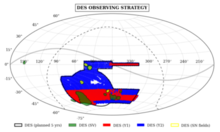
Each year from August through February, observers will stay in dormitories on the mountain. During a weeklong period of work, observers sleep during the day and use the telescope and camera at night. There will be some DES members working at the telescope console to monitor operations while others are monitoring camera operations and data process.
For the wide-area footprint observations, DES takes roughly every two minutes for each new image: The exposures are typically 90 seconds long, with another 30 seconds for readout of the camera data and slewing to point the telescope at its next target. Despite the restrictions on each exposure, the team also need to consider different sky conditions for the observations, such as moonlight and cloud cover.
In order to get better images, DES team use a computer algorithm called the "Observing Tactician" (ObsTac) to help with sequencing observations. It optimizes among different factors, such as the date and time, weather conditions, and the position of the moon. ObsTac automatically points the telescope in the best direction, and selects the exposure, using the best light filter. It also decides whether to take a wide-area or time-domain survey image, depending on whether or not the exposure will also be used for supernova searches.[21]
Results
[edit]Cosmology
[edit]
Dark Energy Group published several papers presenting their results for cosmology. Most of these cosmology results coming from its first-year data and the third-year data. Their results for cosmology were concluded with a Multi-Probe Methodology, which mainly combine the data from Galaxy-Galaxy Lensing, different shape of weak lensing, cosmic shear, galaxy clustering and photometric data set.
For the first-year data collected by DES, Dark Energy Survey Group showed the Cosmological Constraints results from Galaxy Clustering and Weak Lensing results and cosmic shear measurement. With Galaxy Clustering and Weak Lensing results, and for ΛCDM, , and at 68% confidence limits for ωCMD.[22] Combine the most significant measurements of cosmic shear in a galaxy survey, Dark Energy Survey Group showed that at 68% confidence limits and for ΛCDM with .[23] Other cosmological analyses from first year data showed a derivation and validation of redshift distribution estimates and their uncertainties for the galaxies used as weak lensing sources.[24] The DES team also published a paper summarize all the Photometric Data Set for Cosmology for their first-year data.[25]
For the third-year data collected by DES, they updated the Cosmological Constraints to for the ΛCDM model with the new cosmic shear measurements.[26] From third-year data of Galaxy Clustering and Weak Lensing results, DES updated the Cosmological Constraints to and in ΛCDM at 68% confidence limits, , and in ωCDM at 68% confidence limits.[27] Similarly, the DES team published their third-year observations for photometric data set for cosmology comprising nearly 5000 deg2 of grizY imaging in the south Galactic cap, including nearly 390 million objects, with depth reaching S/N ~ 10 for extended objects up to ~ 23.0, and top-of-the-atmosphere photometric uniformity < 3mmag.[28]
Weak lensing
[edit]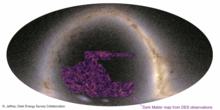
Weak lensing was measured statistically by measuring the shear-shear correlation function, a two-point function, or its Fourier Transform, the shear power spectrum.[31] In April 2015, the Dark Energy Survey released mass maps using cosmic shear measurements of about 2 million galaxies from the science verification data between August 2012 and February 2013.[32] In 2021 weak lensing was used to map the dark matter in a region of the southern hemisphere sky,[29][30] in 2022 together with galaxy clustering data to give new cosmological constrains.[33][34] and in 2023 with data from the Planck telescope and South Pole telescope to give once new improved constraints.[35][36][37][38]
Another big part of weak lensing result is to calibrate the redshift of the source galaxies. In December 2020 and June 2021, DES team published two papers showing their results about using weak lensing to calibrate the redshift of the source galaxies in order to mapping the matter density field with gravitational lensing.[39][40]
Gravitational waves
[edit]After LIGO detected the first gravitational wave signal from GW170817,[41] DES made follow-up observations of GW170817 using DECam. With DECam independent discovery of the optical source, DES team establish its association with GW170817 by showing that none of the 1500 other sources found within the event localization region could plausibly be associated with the event. DES team monitored the source for over two weeks and provide the light curve data as a machine-readable file. From the observation data set, DES concluded that the optical counterpart they have identified near NGC 4993 is associated with GW170817. This discovery ushers in the era of multi-messenger astronomy with gravitational waves and demonstrates the power of DECam to identify the optical counterparts of gravitational-wave sources.[42]
Dwarf galaxies
[edit]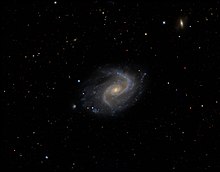
In March 2015, two teams released their discoveries of several new potential dwarf galaxy candidates found in Year 1 DES data.[43] In August 2015, the Dark Energy Survey team announced the discovery of eight additional candidates in Year 2 DES data.[44] Later on, Dark Energy Survey team found more dwarf galaxies. With more Dwarf Galaxy results, the team was able to take a deep look about more properties of the detected Dwarf Galaxy such as the chemical abundance,[45] the structure of stellar population,[46] and Stellar Kinematics and Metallicities.[47] In Feb 2019, the team also discovered a sixth star cluster in the Fornax Dwarf Spheroidal Galaxy[48] and a tidally Disrupted Ultra-Faint Dwarf Galaxy.[49]
Baryon acoustic oscillations
[edit]The signature of baryon acoustic oscillations (BAO) can be observed in the distribution of tracers of the matter density field and used to measure the expansion history of the Universe. BAO can also be measured using purely photometric data, though at less significance.[50] DES team observation samples consists of 7 million galaxies distributed over a footprint of 4100 deg2 with 0.6 < zphoto < 1.1 and a typical redshift uncertainty of 0.03(1+z).[51] From their statistics, they combine the likelihoods derived from angular correlations and spherical harmonics to constrain the ratio of comoving angular diameter distance at the effective redshift of our sample to the sound horizon scale at the drag epoch.[52]
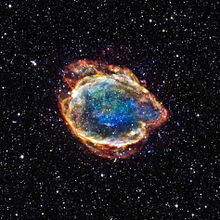
Type Ia supernova observations
[edit]In May 2019, Dark Energy Survey team published their first cosmology results using Type Ia supernovae. The supernova data was from DES-SN3YR. The Dark Energy Survey team found Ωm = 0.331 ± 0.038 with a flat ΛCDM model and Ωm = 0.321 ± 0.018, w = −0.978 ± 0.059 with a flat wCDM model.[53] Analyzing the same data from DES-SN3YR, they also found a new current Hubble constant, .[54] This result has an excellent agreement with the Hubble constant measurement from Planck Satellite Collaboration in 2018.[55] In June 2019, there a follow-up paper was published by DES team discussing the systematic uncertainties, and validation of using the supernovae to measure the cosmology results mentioned before.[56] The team also published their photometric pipeline and light curve data in another paper published in the same month.[57]
Minor planets
[edit]Several minor planets were discovered by DeCam in the course of The Dark Energy Survey, including high-inclination trans-Neptunian objects (TNOs).[58]
List of DES discovered minor planets Numbered MP
designationDiscovery
dateMP list link Ref (451657) 2012 WD36 19 November 2012 list [59] (471954) 2013 RM98 8 September 2013 list [60] (472262) 2014 QN441 18 August 2014 list [61] (483002) 2014 QS441 19 August 2014 list [62] (491767) 2012 VU113 15 November 2012 list [63] (491768) 2012 VV113 15 November 2012 list [64] (495189) 2012 VR113 28 September 2012 list [65] (495190) 2012 VS113 12 November 2012 list [66] (495297) 2013 TJ159 13 October 2013 list [67] Discoveries are credited either to
"DECam" or "Dark Energy Survey".
The MPC has assigned the IAU code W84 for DeCam's observations of small Solar System bodies. As of October 2019, the MPC inconsistently credits the discovery of nine numbered minor planets, all of them trans-Neptunian objects, to either "DeCam" or "Dark Energy Survey".[68] The list does not contain any unnumbered minor planets potentially discovered by DeCam, as discovery credits are only given upon a body's numbering, which in turn depends on a sufficiently secure orbit determination.
Gallery
[edit]-
Dark Energy Survey deep field image[69]
-
The large spiral galaxy in the center of this image is roughly 385 million light-years from Earth.
-
The three large objects in this image captured by the Dark Energy Camera are galaxies in the nearby Fornax cluster, roughly 65 million light-years from Earth.
-
Dark Energy Survey - galaxy NGC 1398
See also
[edit]References
[edit]- ^ "Home". The Dark Energy Survey.
- ^ DES Collaboration Page, DES Collaborators.
- ^ DES-Brazil Archived 2014-10-22 at the Wayback Machine, DES-Brazil Consortium.
- ^ "The Dark Energy Survey Collaboration". www.darkenergysurvey.org. Retrieved 2015-11-21.
- ^ The Project - The Dark Energy Survey Collaboration, The DES Project Site.
- ^ a b c Dark Energy Camera (DECam) Archived 2019-05-23 at the Wayback Machine, Cerro Tololo Inter-American Observatory.
- ^ "DES Year 3 Cosmology Results: Papers". The Dark Energy Survey. Retrieved 3 August 2021.
- ^ "A Sky Full of Galaxies". NOIRLab. Retrieved 12 March 2021.
- ^ a b DECam Presentation Archived 2011-09-27 at the Wayback Machine, Pdf Presentation about the specific details about how a CCD device works and about the specific properties of the DECam, made by a Fermilab specialist.
- ^ "Camera | SDSS".
- ^ Flaugher, Brenna L.; et al. (September 24, 2012). "Status of the Dark Energy Survey Camera (DECam) project". In McLean, Ian S; Ramsay, Suzanne K; Takami, Hideki (eds.). Ground-based and Airborne Instrumentation for Astronomy IV. Vol. 8446. International Society for Optics and Photonics. pp. 343–357. doi:10.1117/12.926216. S2CID 121613505 – via www.spiedigitallibrary.org.
- ^ "The Camera". The Dark Energy Survey. Retrieved 2024-05-02.
- ^ a b "NOAO: A Survey Machine and a Data Trove – Dark Energy Survey's Rich Legacy | CTIO". www.ctio.noao.edu. Archived from the original on 22 September 2021. Retrieved 3 August 2021.
- ^ Dark Energy Survey Collaboration. "Description of the Dark Energy Survey for Astronomers" (PDF). The Dark Energy Survey. Retrieved 1 March 2015.
- ^ "Dark energy camera snaps first images ahead of survey". BBC. 2012-09-18.
- ^ "The Dark Energy Survey begins". Fermilab. 2013-09-03.
- ^ Survey, Legacy (2012-11-08). "The Dark Energy Camera Legacy Survey (DECaLS)". Legacy Survey. Retrieved 2023-12-31.
- ^ a b Dey, Arjun; Schlegel, David J.; Lang, Dustin; Blum, Robert; Burleigh, Kaylan; Fan, Xiaohui; Findlay, Joseph R.; Finkbeiner, Doug; Herrera, David; Juneau, Stéphanie; Landriau, Martin; Levi, Michael; McGreer, Ian; Meisner, Aaron; Myers, Adam D. (2019-05-01). "Overview of the DESI Legacy Imaging Surveys". The Astronomical Journal. 157 (5): 168. arXiv:1804.08657. Bibcode:2019AJ....157..168D. doi:10.3847/1538-3881/ab089d. ISSN 0004-6256.
- ^ Survey, Legacy (2023-09-28). "Data Release Description". Legacy Survey. Retrieved 2023-12-31.
- ^ Schlafly, E. F.; Green, G. M.; Lang, D.; Daylan, T.; Finkbeiner, D. P.; Lee, A.; Meisner, A. M.; Schlegel, D.; Valdes, F. (2018-02-01). "The DECam Plane Survey: Optical Photometry of Two Billion Objects in the Southern Galactic Plane". The Astrophysical Journal Supplement Series. 234 (2): 39. arXiv:1710.01309. Bibcode:2018ApJS..234...39S. doi:10.3847/1538-4365/aaa3e2. ISSN 0067-0049.
- ^ "Observations". The Dark Energy Survey. Survey and operations.
- ^ DES Collaboration; Abbott, T. M. C.; Abdalla, F. B.; Alarcon, A.; Aleksić, J.; Allam, S.; Allen, S.; Amara, A.; Annis, J.; Asorey, J.; Avila, S. (2018-08-27). "Dark Energy Survey Year 1 Results: Cosmological Constraints from Galaxy Clustering and Weak Lensing". Physical Review D. 98 (4): 043526. arXiv:1708.01530. Bibcode:2018PhRvD..98d3526A. doi:10.1103/PhysRevD.98.043526. ISSN 2470-0010. S2CID 52219057.
- ^ Troxel, M. A.; MacCrann, N.; Zuntz, J.; Eifler, T. F.; Krause, E.; Dodelson, S.; Gruen, D.; Blazek, J.; Friedrich, O.; Samuroff, S.; Prat, J. (2018-08-27). "Dark Energy Survey Year 1 Results: Cosmological Constraints from Cosmic Shear". Physical Review D. 98 (4): 043528. arXiv:1708.01538. Bibcode:2018PhRvD..98d3528T. doi:10.1103/PhysRevD.98.043528. ISSN 2470-0010. S2CID 52993521.
- ^ Hoyle, B.; Gruen, D.; Bernstein, G. M.; Rau, M. M.; De Vicente, J.; Hartley, W. G.; Gaztanaga, E.; DeRose, J.; Troxel, M. A.; Davis, C.; Alarcon, A. (2018-07-21). "Dark Energy Survey Year 1 Results: Redshift distributions of the weak lensing source galaxies". Monthly Notices of the Royal Astronomical Society. 478 (1): 592–610. arXiv:1708.01532. doi:10.1093/mnras/sty957. ISSN 0035-8711.
- ^ Drlica-Wagner, A.; Sevilla-Noarbe, I.; Rykoff, E. S.; Gruendl, R. A.; Yanny, B.; Tucker, D. L.; Hoyle, B.; Rosell, A. Carnero; Bernstein, G. M.; Bechtol, K.; Becker, M. R. (2018-04-03). "Dark Energy Survey Year 1 Results: Photometric Data Set for Cosmology". The Astrophysical Journal Supplement Series. 235 (2): 33. arXiv:1708.01531. Bibcode:2018ApJS..235...33D. doi:10.3847/1538-4365/aab4f5. ISSN 1538-4365. S2CID 53967977.
- ^ Porredon, A.; Crocce, M.; Elvin-Poole, J.; Cawthon, R.; Giannini, G.; De Vicente, J.; Rosell, A. Carnero; Ferrero, I.; Krause, E.; Fang, X.; Prat, J. (2022). "Dark Energy Survey Year 3 results: Cosmological constraints from galaxy clustering and galaxy-galaxy lensing using the MagLim lens sample". Physical Review D. 106 (10): 103530. arXiv:2105.13546. Bibcode:2022PhRvD.106j3530P. doi:10.1103/PhysRevD.106.103530. S2CID 235247869.
- ^ DES Collaboration; Abbott, T. M. C.; Aguena, M.; Alarcon, A.; Allam, S.; Alves, O.; Amon, A.; Andrade-Oliveira, F.; Annis, J.; Avila, S.; Bacon, D. (2022-01-13). "Dark Energy Survey Year 3 results: Cosmological constraints from galaxy clustering and weak lensing". Physical Review D. 105 (2): 023520. arXiv:2105.13549. Bibcode:2022PhRvD.105b3520A. doi:10.1103/PhysRevD.105.023520. hdl:10852/94381. S2CID 245959154.
- ^ Sevilla-Noarbe, I.; Bechtol, K.; Kind, M. Carrasco; Rosell, A. Carnero; Becker, M. R.; Drlica-Wagner, A.; Gruendl, R. A.; Rykoff, E. S.; Sheldon, E.; Yanny, B.; Alarcon, A. (2021-06-01). "Dark Energy Survey Year 3 Results: Photometric Data Set for Cosmology". The Astrophysical Journal Supplement Series. 254 (2): 24. arXiv:2011.03407. Bibcode:2021ApJS..254...24S. doi:10.3847/1538-4365/abeb66. ISSN 0067-0049. S2CID 226278355.
- ^ a b Jeffrey, N; Gatti, M; Chang, C; Whiteway, L; Demirbozan, U; Kovacs, A; Pollina, G; Bacon, D; Hamaus, N; Kacprzak, T; Lahav, O (2021-06-25). "Dark Energy Survey Year 3 results: Curved-sky weak lensing mass map reconstruction". Monthly Notices of the Royal Astronomical Society. 505 (3): 4626–4645. arXiv:2105.13539. doi:10.1093/mnras/stab1495. ISSN 0035-8711.
- ^ a b Castelvecchi, Davide (2021-05-28). "The most detailed 3D map of the Universe ever made". Nature: d41586–021–01466-1. doi:10.1038/d41586-021-01466-1. ISSN 0028-0836. PMID 34050347. S2CID 235242965.
- ^ "The Dark Energy Survey Science Program" (PDF). Archived from the original (PDF) on 2011-07-20. Retrieved 2010-12-02.
- ^ "Mapping the cosmos: Dark Energy Survey creates detailed guide to spotting dark matter". 13 April 2015.
- ^ Abbott, T. M. C.; Aguena, M.; Alarcon, A.; Allam, S.; Alves, O.; Amon, A.; Andrade-Oliveira, F.; Annis, J.; Avila, S.; Bacon, D.; Baxter, E. (2022-01-13). "Dark Energy Survey Year 3 results: Cosmological constraints from galaxy clustering and weak lensing". Physical Review D. 105 (2): 023520. arXiv:2105.13549. Bibcode:2022PhRvD.105b3520A. doi:10.1103/PhysRevD.105.023520. hdl:10852/94381. ISSN 2470-0010. S2CID 245959154.
- ^ Schirber, Michael (2022-01-13). "Dark Energy Survey Hits a Triple". Physics. 15. Bibcode:2022PhyOJ..15...s4S. doi:10.1103/Physics.15.s4. S2CID 247259733.
- ^ DES and SPT Collaborations; Omori, Y.; Baxter, E. J.; Chang, C.; Friedrich, O.; Alarcon, A.; Alves, O.; Amon, A.; Andrade-Oliveira, F.; Bechtol, K.; Becker, M. R.; Bernstein, G. M.; Blazek, J.; Bleem, L. E.; Camacho, H. (2023-01-31). "Joint analysis of Dark Energy Survey Year 3 data and CMB lensing from SPT and Planck. I. Construction of CMB lensing maps and modeling choices". Physical Review D. 107 (2): 023529. arXiv:2203.12439. Bibcode:2023PhRvD.107b3529O. doi:10.1103/PhysRevD.107.023529. hdl:10261/336767. S2CID 256493553.
- ^ DES & SPT Collaborations; Chang, C.; Omori, Y.; Baxter, E. J.; Doux, C.; Choi, A.; Pandey, S.; Alarcon, A.; Alves, O.; Amon, A.; Andrade-Oliveira, F.; Bechtol, K.; Becker, M. R.; Bernstein, G. M.; Bianchini, F. (2023-01-31). "Joint analysis of Dark Energy Survey Year 3 data and CMB lensing from SPT and $Planck$. II. Cross-correlation measurements and cosmological constraints". Physical Review D. 107 (2): 023530. arXiv:2203.12440. Bibcode:2023PhRvD.107b3530C. doi:10.1103/PhysRevD.107.023530. hdl:10261/336776. S2CID 256480388.
- ^ DES and SPT Collaborations; Abbott, T. M. C.; Aguena, M.; Alarcon, A.; Alves, O.; Amon, A.; Andrade-Oliveira, F.; Annis, J.; Ansarinejad, B.; Avila, S.; Bacon, D.; Baxter, E. J.; Bechtol, K.; Becker, M. R.; Benson, B. A. (2023-01-31). "Joint analysis of Dark Energy Survey Year 3 data and CMB lensing from SPT and Planck. III. Combined cosmological constraints". Physical Review D. 107 (2): 023531. arXiv:2206.10824. Bibcode:2023PhRvD.107b3531A. doi:10.1103/PhysRevD.107.023531. hdl:10261/336780. S2CID 249926390.
- ^ Gasparini, Allison (2023-01-31). "Cosmological Parameters Improved by Combining Data". Physics. 16 (2): s12. arXiv:2203.12439. Bibcode:2023PhRvD.107b3529O. doi:10.1103/PhysRevD.107.023529. hdl:10261/336767. S2CID 256493553.
- ^ Gatti, M.; Giannini, G.; Bernstein, G. M.; Alarcon, A.; Myles, J.; Amon, A.; Cawthon, R.; Troxel, M.; DeRose, J.; Everett, S.; Ross, A. J. (2021-12-24). "Dark Energy Survey Year 3 Results: Clustering Redshifts -- Calibration of the Weak Lensing Source Redshift Distributions with redMaGiC and BOSS/eBOSS". Monthly Notices of the Royal Astronomical Society. 510 (1): 1223–1247. arXiv:2012.08569. doi:10.1093/mnras/stab3311. ISSN 0035-8711.
- ^ Myles, J.; Alarcon, A.; Amon, A.; Sánchez, C.; Everett, S.; DeRose, J.; McCullough, J.; Gruen, D.; Bernstein, G. M.; Troxel, M. A.; Dodelson, S. (2021-06-23). "Dark Energy Survey Year 3 Results: Redshift Calibration of the Weak Lensing Source Galaxies". Monthly Notices of the Royal Astronomical Society. 505 (3): 4249–4277. arXiv:2012.08566. doi:10.1093/mnras/stab1515. ISSN 0035-8711.
- ^ The LIGO Scientific Collaboration; The Virgo Collaboration (2017-10-16). "GW170817: Observation of Gravitational Waves from a Binary Neutron Star Inspiral". Physical Review Letters. 119 (16): 161101. arXiv:1710.05832. Bibcode:2017PhRvL.119p1101A. doi:10.1103/PhysRevLett.119.161101. ISSN 0031-9007. PMID 29099225. S2CID 217163611.
- ^ Soares-Santos, M.; Holz, D. E.; Annis, J.; Chornock, R.; Herner, K.; Berger, E.; Brout, D.; Chen, H.; Kessler, R.; Sako, M.; Allam, S. (2017-10-16). "The Electromagnetic Counterpart of the Binary Neutron Star Merger LIGO/Virgo GW170817. I. Dark Energy Camera Discovery of the Optical Counterpart". The Astrophysical Journal. 848 (2): L16. arXiv:1710.05459. doi:10.3847/2041-8213/aa9059. ISSN 2041-8213. S2CID 119399798.
- ^ "Scientists find rare dwarf satellite galaxy candidates in Dark Energy Survey data". 10 March 2015.
- ^ Drlica-Wagner, A.; et al. (November 4, 2015). "Eight Ultra-faint Galaxy Candidates Discovered in Year Two of the Dark Energy Survey". The Astrophysical Journal. 813 (2): 109. arXiv:1508.03622. Bibcode:2015ApJ...813..109D. doi:10.1088/0004-637X/813/2/109. hdl:10183/140479. S2CID 55909299.
- ^ Hansen, T. T.; Marshall, J. L.; Simon, J. D.; Li, T. S.; Bernstein, R. A.; Pace, A. B.; Ferguson, P.; Nagasawa, D. Q.; Kuehn, K.; Carollo, D.; Geha, M. (2020-07-16). "Chemical Analysis of the Ultrafaint Dwarf Galaxy Grus II. Signature of High-mass Stellar Nucleosynthesis". The Astrophysical Journal. 897 (2): 183. arXiv:2005.10767. Bibcode:2020ApJ...897..183H. doi:10.3847/1538-4357/ab9643. hdl:10261/234987. ISSN 1538-4357. S2CID 218763518.
- ^ Wang, M. Y.; de Boer, T.; Pieres, A.; Li, T. S.; Drlica-Wagner, A.; Koposov, S. E.; Vivas, A. K.; Pace, A. B.; Santiago, B.; Walker, A. R.; Tucker, D. L. (2019-08-21). "The Morphology and Structure of Stellar Populations in the Fornax Dwarf Spheroidal Galaxy from Dark Energy Survey Data". The Astrophysical Journal. 881 (2): 118. arXiv:1809.07801. Bibcode:2019ApJ...881..118W. doi:10.3847/1538-4357/ab31a9. ISSN 1538-4357. S2CID 119088745.
- ^ Simon, J. D.; Drlica-Wagner, A.; Li, T. S.; Nord, B.; Geha, M.; Bechtol, K.; Balbinot, E.; Buckley-Geer, E.; Lin, H.; Marshall, J.; Santiago, B. (2015-07-23). "Stellar Kinematics and Metallicities in the Ultra-Faint Dwarf Galaxy Reticulum Ii". The Astrophysical Journal. 808 (1): 95. arXiv:1504.02889. Bibcode:2015ApJ...808...95S. doi:10.1088/0004-637X/808/1/95. hdl:1969.1/185483. ISSN 1538-4357. S2CID 17352150.
- ^ Wang, M. Y.; Koposov, S.; Drlica-Wagner, A.; Pieres, A.; Li, T. S.; de Boer, T.; Bechtol, K.; Belokurov, V.; Pace, A. B.; Bacon, D.; Abbott, T. M. C. (2019-04-16). "Rediscovery of the Sixth Star Cluster in the Fornax Dwarf Spheroidal Galaxy". The Astrophysical Journal. 875 (2): L13. arXiv:1902.04589. Bibcode:2019ApJ...875L..13W. doi:10.3847/2041-8213/ab14f5. ISSN 2041-8213. S2CID 119044713.
- ^ Li, T. S.; Simon, J. D.; Kuehn, K.; Pace, A. B.; Erkal, D.; Bechtol, K.; Yanny, B.; Drlica-Wagner, A.; Marshall, J. L.; Lidman, C.; Balbinot, E. (2018-10-05). "The First Tidally Disrupted Ultra-faint Dwarf Galaxy?: A Spectroscopic Analysis of the Tucana III Stream". The Astrophysical Journal. 866 (1): 22. arXiv:1804.07761. Bibcode:2018ApJ...866...22L. doi:10.3847/1538-4357/aadf91. hdl:1885/186419. ISSN 1538-4357. S2CID 55274010.
- ^ The Dark Energy Survey Collaboration; Abbott, T. M. C.; Abdalla, F. B.; Alarcon, A.; Allam, S.; Andrade-Oliveira, F.; Annis, J.; Avila, S.; Banerji, M.; Banik, N.; Bechtol, K. (2019-03-11). "Dark Energy Survey Year 1 Results: Measurement of the Baryon Acoustic Oscillation scale in the distribution of galaxies to redshift 1". Monthly Notices of the Royal Astronomical Society. 483 (4): 4866–4883. arXiv:1712.06209. doi:10.1093/mnras/sty3351. ISSN 0035-8711.
- ^ Rosell, A. Carnero; Rodriguez-Monroy, M.; Crocce, M.; Elvin-Poole, J.; Porredon, A.; Ferrero, I.; Mena-Fernandez, J.; Cawthon, R.; De Vicente, J.; Gaztanaga, E.; Ross, A. J. (2021-11-10). "Dark Energy Survey Year 3 Results: Galaxy Sample for BAO Measurement". Monthly Notices of the Royal Astronomical Society. 509 (1): 778–799. arXiv:2107.05477. doi:10.1093/mnras/stab2995. ISSN 0035-8711.
- ^ DES Collaboration; Abbott, T. M. C.; Aguena, M.; Allam, S.; Andrade-Oliveira, F.; Asorey, J.; Avila, S.; Bernstein, G. M.; Bertin, E.; Brandao-Souza, A.; Brooks, D. (2022-02-08). "Dark Energy Survey Year 3 Results: A 2.7% measurement of Baryon Acoustic Oscillation distance scale at redshift 0.835". Physical Review D. 105 (4): 043512. arXiv:2107.04646. Bibcode:2022PhRvD.105d3512A. doi:10.1103/PhysRevD.105.043512. hdl:10852/94783. ISSN 2470-0010. S2CID 235795204.
- ^ Abbott, T. M. C.; Allam, S.; Andersen, P.; Angus, C.; Asorey, J.; Avelino, A.; Avila, S.; Bassett, B. A.; Bechtol, K.; Bernstein, G. M.; Bertin, E. (2019-02-21). "First Cosmology Results using Type Ia Supernovae from the Dark Energy Survey: Constraints on Cosmological Parameters". The Astrophysical Journal. 872 (2): L30. arXiv:1811.02374. Bibcode:2019ApJ...872L..30A. doi:10.3847/2041-8213/ab04fa. ISSN 2041-8213. S2CID 84833144.
- ^ Macaulay, E.; Nichol, R. C.; Bacon, D.; Brout, D.; Davis, T. M.; Zhang, B.; Bassett, B. A.; Scolnic, D.; Möller, A.; D'Andrea, C. B.; Hinton, S. R. (2019-06-21). "First Cosmological Results using Type Ia Supernovae from the Dark Energy Survey: Measurement of the Hubble Constant". Monthly Notices of the Royal Astronomical Society. 486 (2): 2184–2196. arXiv:1811.02376. doi:10.1093/mnras/stz978. ISSN 0035-8711.
- ^ Larivière, Vincent; Sugimoto, Cassidy R.; Macaluso, Benoit; Milojević, Staša; Cronin, Blaise; Thelwall, Mike (2014-01-27). "arXiv E-prints and the journal of record: An analysis of roles and relationships". Journal of the Association for Information Science and Technology. 65 (6): 1157–1169. arXiv:1306.3261. Bibcode:2014JASIS..65.1157L. doi:10.1002/asi.23044. ISSN 2330-1635. S2CID 30584899.
- ^ Brout, D.; Scolnic, D.; Kessler, R.; D'Andrea, C. B.; Davis, T. M.; Gupta, R. R.; Hinton, S. R.; Kim, A. G.; Lasker, J.; Lidman, C.; Macaulay, E. (2019-04-02). "First Cosmology Results Using Type Ia Supernovae From the Dark Energy Survey: Analysis, Systematic Uncertainties, and Validation". The Astrophysical Journal. 874 (2): 150. arXiv:1811.02377. doi:10.3847/1538-4357/ab08a0. ISSN 1538-4357. S2CID 119537585.
- ^ Brout, D.; Sako, M.; Scolnic, D.; Kessler, R.; D'Andrea, C. B.; Davis, T. M.; Hinton, S. R.; Kim, A. G.; Lasker, J.; Macaulay, E.; Möller, A. (2019-03-27). "First Cosmology Results Using Type Ia Supernovae From the Dark Energy Survey: Photometric Pipeline and Light Curve Data Release". The Astrophysical Journal. 874 (1): 106. arXiv:1811.02378. Bibcode:2019ApJ...874..106B. doi:10.3847/1538-4357/ab06c1. ISSN 1538-4357. S2CID 102487487.
- ^ Becker, J.C.; Khain, T.; Hamilton, S.J.; Adams, F.C.; Gerdes, D.W.; Zullo, L.; et al. (DES Collaboration) (2018). "Discovery and dynamical analysis of an extreme trans-Neptunian object with a high orbital inclination". The Astronomical Journal. 156 (2): 81. arXiv:1805.05355. Bibcode:2018AJ....156...81B. doi:10.3847/1538-3881/aad042. S2CID 55163842.
- ^ "JPL Small-Body Database Browser". ssd.jpl.nasa.gov. 2 451657.
- ^ Chamberlin, Alan. "JPL Small-Body Database Browser". ssd.jpl.nasa.gov. 2 471954.
- ^ "JPL Small-Body Database Browser". ssd.jpl.nasa.gov. 2 472262.
- ^ "JPL Small-Body Database Browser". ssd.jpl.nasa.gov. 2 483002.
- ^ "JPL Small-Body Database Browser". ssd.jpl.nasa.gov. 2 491767.
- ^ "JPL Small-Body Database Browser". ssd.jpl.nasa.gov. 2 491768.
- ^ "JPL Small-Body Database Browser". ssd.jpl.nasa.gov. 2 495189.
- ^ "JPL Small-Body Database Browser". ssd.jpl.nasa.gov. 2 495190.
- ^ "JPL Small-Body Database Browser". ssd.jpl.nasa.gov. 2 495297.
- ^ "Minor Planet Discoverers (by number)". Minor Planet Center. 15 November 2016. Retrieved 27 January 2017.
- ^ "Dark Energy Survey Releases Most Precise Look at the Universe's Evolution". NOIRLab Press Release. Retrieved 17 June 2021.
External links
[edit]- Dark Energy Survey website
- Dark Energy Survey Science Program (PDF)
- Dark Energy Survey Data Management
- Dark Energy Camera (DECam) Archived 2017-10-18 at the Wayback Machine
- Biron, Lauren (4 October 2022). "15 spectacular photos from the Dark Energy Camera". symmetry magazine.


















